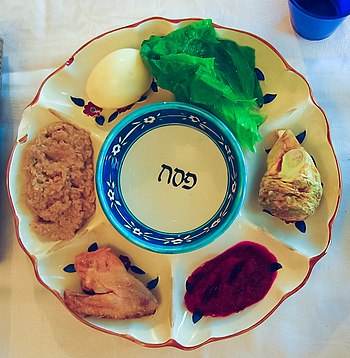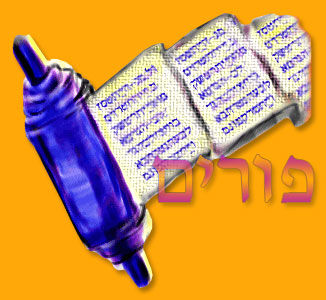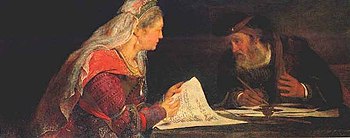Overview
The Feast of Tabernacles is a week-long autumn harvest festival. The Feast of Tabernacles is also known as the Feast of the Ingathering, Feast of Booths, Sukkoth, Succoth, or Sukkot (variations in spellings occur because these words are transliterations of the Hebrew word pronounced “Sue-COAT”). The two days following the festival are separate holidays, Shemini Atzeret and Simchat Torah, but are commonly thought of as part of the Feast of Tabernacles.
The Feast of Tabernacles was the final and most important Appointed Time of the year. The importance of this festival is indicated by the statement, “This is to be a lasting ordinance.” The divine pronouncement, “I am the Lord your God,” concludes this section on the holy days of the seventh month. The Feast of Tabernacles begins five days after Yom Kippur, on the fifteenth of Tishri (September or October). It is a drastic change from one of the most solemn holy days in our year to one of the most joyous. The word Sukkot means “booths,” and refers to the temporary dwellings that followers of the Torah are commanded to live in during this holy day, just as the Jews did in the wilderness. The Feast of Tabernacles lasts for seven days and ends on the twenty-first day (3×7) of the Hebrew month of Tishri, which is Israel’s seventh month.
This holy day has a dual significance: historical and agricultural (just as Pesach and Shavuot). Historically, it was to be kept in remembrance of the dwelling in tents in the wilderness for the forty-year period during which the children of Israel were wandering in the desert. It is expounded in Leviticus 23:43, “That your generations may know that I made the children of Israel to dwell in booths, when I brought them out of the land of Egypt: I am the LORD your God.”
What were they to remember?
1. The meaning of their beginning, and the low and desolate state out of which God advanced them.
2. The mercy of God to them, that, when they dwelt in tabernacles, God not only set up a tabernacle for Himself among them, but with the utmost care and tenderness imaginable, hung a canopy over them, even the cloud that sheltered them from the heat of the sun. God’s former mercies to us and our fathers ought to be kept in everlasting remembrance. The eighth day was the great day of this festival, because then they returned to their own houses again and remembered how, after they had long dwelt in tents in the wilderness, they came to a happy settlement in the land of promise, where they dwelt in goodly houses. And they would more sensibly value and be thankful for the comforts and conveniences of their houses when they had been seven days dwelling in booths. It is good for those that have ease and plenty sometimes to learn what it is to endure hardness.
They were to keep this holy day in thankfulness to God for all the increase of the year; however, the emphasis is that Israel’s life rested upon redemption which in its ultimate meaning is the forgiveness of sin. This fact separates this holy day from the harvest festivals of the neighboring nations whose roots lay in the mythological activity of the gods.
Was the first Thanksgiving a Feast of Tabernacles Celebration?
Many Americans, upon seeing a decorated Sukkah for the first time, remark on how much the Sukkah (and the festival generally) reminds them of Thanksgiving. The American pilgrims, who originated the Thanksgiving holiday, were deeply religious people. As they were trying to find a way to express their thanks for their survival and for the harvest, it is quite possible that they looked to the Bible (Leviticus 23:39) for an appropriate way of celebrating and based their holiday in part on the Feast of Tabernacles.
Note: celebrating Thanksgiving on the third Thursday of November was established by the American government and may not necessarily coincide with the pilgrim’s first observance.
Sukkot, The Festival of Booths
Four days after Yom Kippur, we join together to celebrate Sukkot. The holiday is celebrated from the 15th of Tishri through the 21st or 22nd of Tishri, depending if you live in Israel or in the Diaspora. Sukkot usually falls in late September or early October.
After the harvest from your threshing floor and your vineyards, you shall celebrate the Feast of Booths for seven days. (Deuteronomy 16:13)
You shall live in booths seven days in order that future generations may know that I made the Israelite people live in booths when I brought them out of the land of Egypt. (Leviticus 23:42-43)
Historically, Sukkot commemorates the wanderings of the Israelites, which began with the exodus from Egypt (Passover) and continues with the giving of the Torah at Sinai (Shavuot) and ends with the wandering in the desert for the full 40 years as punishment for the sin of the golden calf. A major agricultural festival, Sukkot is also the third of the shalosh regalim, or three pilgrimage holidays, when it was the custom of Jews everywhere to converge onto Jerusalem every Passover, Shavuot and Sukkot. Sukkot also marks the end of a long harvest, the time of year when farmers finish their work. Traditionally, this was the time for grapes to be gathered and made into raisins or wine; for olives to be picked and pressed into oil; and fruits to either ripen, or be eaten or stored.
To celebrate their hard work, the farmers and their families would go to the temple in Jerusalem to offer thanks. They built Sukkot, or booths, to remember how the children of Israel built booths in the desert. The pilgrims lived in them for seven days while they, and the families they brought to Jerusalem, celebrated.
This is also why Sukkot is known as hag-ha-asif, the festival of ingathering.
You shall celebrate the festival of ingathering, at the end of the year, when you gather in your labors out of the field. (Exodus 23:16)
In addition, because of its strong agricultural elements, some scholars believe that the current custom of building your own Sukkah stems from the harvest when workers would live in temporary huts in fields. They argue that our Sukkot with their open roofs bear more resemblance to the harvester’s huts than they do with the dwellings the Jews lived in the desert.
Sukkot is a happy festival. In biblical times, Sukkot was considered to be the most important festival. It was actually referred to as ha-chag, The Festival (Kings 12:32). King Solomon chose Sukkot as the holiday during which he consecrated the first temple. It was also the occasion every seven years for the ceremony hak’heil, the public reading of the Torah before the whole people (Deuteronomy 31:10-13). Sukkot is also said to be the festival of the future, when in the messianic period, all nations will come to Jerusalem and celebrate.
The only time celebrating Sukkot was suspended was during the Babylonian exile since the festival was so connected to rejoicing at the temple and harvesting the land. During the next century, when the Jews returned to Israel under the leadership of Ezra and Nehemiah, they were ready to embrace the Torah’s commandments. The Jews, ecstatic to be reunited with the land, built Sukkot out of olive, pine, myrtle, and palm branches. The importance of Sukkot continued during the second temple era, with pilgrims coming to Jerusalem from Jewish communities all over. They participated in praying and singing and joining in the religious processions.
The etrog and the four species- palm, willow and myrtle, which are bundled together to make a lulav – became part of the ritual.
Arba Minim: The Four Species
On the first day, you will take for yourselves a fruit of a beautiful tree, palm branches, twigs of a braided tree and brook willows, and you will rejoice before the L-RD your G-d for seven days. (Leviticus 23:40)
Another observance during Sukkot involves what are known as the Four Species (arba minim) or the lulav and etrog. We are to take these four plants and use them to “rejoice before the L-rd.” The four species in question are an etrog (a citrus fruit similar to a lemon native to Israel; in English it is called a citron), a palm branch (in Hebrew, lulav), two willow branches (aravot) and three myrtle branches (hadassim). The six branches are bound together and referred to collectively as the lulav, because the palm branch is by far the largest part. The etrog is held separately. With these four species in hand, one recites a blessing and waves the species in all six directions (east, south, west, north, up and down), symbolizing the fact that G-d is everywhere. Detailed instructions for this ritual can be found under Sukkot Blessings.
The four species are also held and waved during the Hallel prayer in religious services, and are held during processions around the bema.
Why are these four plants used in this service? It can be said that they represent different parts (or Believers) within the body of Messiah. The etrog, which has both a pleasing taste and a pleasing scent, represents those who have achieved both knowledge of Torah and performance of mitzvot. The palm branch, which produces tasty fruit, but has no scent, represents those who have knowledge of Torah but are lacking in mitzvot. The myrtle leaf, which has a strong scent but no taste, represents those who perform mitzvot but have little knowledge of Torah. The willow, which has neither taste nor scent, represents those who have no knowledge of Torah and do not perform the mitvot. We bring all four of these species together on Sukkot to remind us that every one of these four kinds of Believer is important to G-d, and that we must all be united as we grow together in Him.
Sukkot changed little following the destruction of the second temple. However, in its memory, Rabbi Yokhanan ben Zakkai, a leading rabbinic authority at the time, instructed that ceremonies using the four species be performed every day of the week except on Shabbat, even though the Torah only commands to use them on the first day of the festival (Leviticus 23:40).
Sukkot Berachot (Blessings)
Stand facing the east (or whatever direction is toward Jerusalem from where you are). Take the etrog in your left hand with the stem (green tip) up and the pitam (brown tip) down. Take the lulav (including the palm, myrtle and willow branches bound together) in your right hand. Bring your hands together and recite the blessing.
Barukh atah Adonai, Elohaynu, melekh ha-olam
Blessed are you, Lord, our God, king of the universe
asher keedishanu b’meetzvotav v’tzeevanu
who has sanctified us with His commandments and commanded us
al n’tilat lulav (Amein)
to take up the lulav (Amen)
After you recite the blessing, turn the etrog so the stem is down. With the lulav and etrog together, gently shake forward (East) three times, then pull the lulav and etrog back in front of your chest. Repeat this to the right (South), then over your right shoulder (West), then to the left (North), then up, then down.
Hoshanah Rabbah
“L-rd Save, with great (power)!”
The seventh (and last) day of Sukkot is called Hoshana Rabbah. Tradition records that the heavenly decrees made on Yom Teruah/Rosh Hashanah (and sealed on Yom Kippur) are actually sent out on Hoshana Rabbah. Our sages taught us that the nations of the world are judged on this day.
“Yes! I tell you that there are some people standing here who will not experience death until they see the Son of Man coming in his Kingdom!” Six days later, Yeshua took Kefa, Ya‘akov and his brother Yochanan and led them up a high mountain privately. As they watched, he began to change form—his face shone like the sun, and his clothing became as white as light. Then they looked and saw Moshe and Eliyahu speaking with him. Kefa said to Yeshua, “It’s good that we’re here, Lord. I’ll put up three shelters if you want—one for you, one for Moshe and one for Eliyahu.” While he was still speaking, a bright cloud enveloped them; and a voice from the cloud said, “This is my Son, whom I love, with whom I am well pleased. Listen to him!” When the talmidim heard this, they were so frightened that they fell face down on the ground. But Yeshua came and touched them. “Get up!” he said, “Don’t be afraid.” So they opened their eyes, looked up and saw only Yeshua by himself. As they came down the mountain, Yeshua ordered them, “Don’t tell anyone what you have seen until the Son of Man has been raised from the dead.” The talmidim asked him, “Then why do the Torah-teachers say that Eliyahu must come first?” He answered, “On the one hand, Eliyahu is coming and will restore all things; on the other hand, I tell you that Eliyahu has come already, and people did not recognize him but did whatever they pleased to him. In the same way, the Son of Man too is about to suffer at their hands.” Then the talmidim understood that he was talking to them about Yochanan the Immerser. (Matthew 16:28-17:13)
(See also Mark 9:1-13 and Luke 9:27-36)
For when we made known to you the power and the coming of our Lord Yeshua the Messiah, we did not rely on cunningly contrived myths. On the contrary, we saw his majesty with our own eyes. For we were there when he received honor and glory from God the Father; and the voice came to him from the grandeur of the Shechinah, saying, “This is my son, whom I love; I am well Pleased with him!” We heard this voice come out of heaven when we were with him on the holy mountain. (2 Peter 1:16-18)
The next day a great multitude that had come to the feast, when they heard that Yeshua was coming to Jerusalem, took branches of palm trees and went out to meet Him, and cried out:
“Hosanna! ‘Blessed is He who comes in the name of the LORD!’ The King of Israel!”
Then Yeshua, when He had found a young donkey, sat on it; as it is written:
“Fear not, daughter of Zion; Behold, your King is coming, Sitting on a donkey’s colt.”
His disciples did not understand these things at first; but when Jesus was glorified, then they remembered that these things were written about Him and that they had done these things to Him. Therefore the people, who were with Him when He called Lazarus out of his tomb and raised him from the dead, bore witness. For this reason the people also met Him, because they heard that He had done this sign. The Pharisees therefore said among themselves, “You see that you are accomplishing nothing. Look, the world has gone after Him!” (John 12:12-19)
Shemini Atzeret
The day following the seventh day of Sukkot, called Shemini Atzeret (The Eighth Day of Assembly), was reserved for a special set of sacrifices for the benefit of Israel and for a special prayer for rainfall. Not completely understood, Shemini, meaning eight, and Atzeret, meaning solemn assembly; referred to an extra set of rituals performed at the close of the holiday. A midrash, or allegory, explains that as the children of Israel are about to take leave of G-d after having rejoiced with Him since the beginning of Rosh Ha Shanna. G-d, like the parent of a child about to end a cherished visit, says, “It is difficult to have you leave me. Stay another day.”
Simchat Torah
As life in the Diaspora continued, it became customary on the second day of Shemini Atzeret, to remove Torah scrolls from the ark and circle around the bimah, the traditional stage located in the center of the synagogue where the Torah is read. The timing of the celebration is significant in that the cycle of Torah study begins anew at the following Shabbat. The celebration marks the completion of a whole year of Torah study and the anticipation of what HaShem will teach is as we begin again.
Named Simkhat Torah, “rejoicing with the Torah”, the custom became its own holiday, especially for children, with dancing and singing in the synagogue and festive meals at home. In Israel, Shemini Atzeret and Simchat Torah are celebrated together on theday after the seventh day of Sukkot.
In modern times, the custom of building Sukkot was reestablished in the early 1900s. Since then, Jews everywhere celebrate the seven or eight days of Sukkot, (depending where you live) including Shemini Atzeret and Simchat Torah from the Diaspora and from Israel.












